|
Akha |
|
|
Villages of these colorful people are to be found in the mountains of China, Laos Myanmar (Burma) and northern Thailand. Every Akha village is distinguished by their carved wooden gates, presided over by guardian spirits. They live on marginal land and find it difficult to eke out a living through their slash and burn method of agriculture. In order to supplement their income, many Akha are now selling handicrafts, employing the traditional skills used in making their own clothing and cultural items. 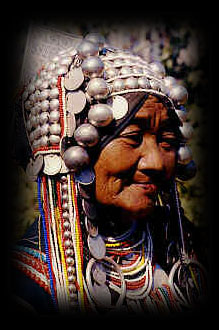 |
The Akha Heritage Foundation Our goal over the years has been to assist the Akha people in whatever way possible to help them overcome the effects of rapid economic development in this region and many other negative events that are bringing great harm to them as a people. The hilltribes of Thailand-Akha Information about the Akha tribe in the highlands of Thailand. |
| Hmong |
|
|
The Hmong are divided in two sub-groups, White and Blue. They live in the mountainous regions of China, Vietnam, Laos and Thailand. The Hmong live in houses that sit right on the ground, not on stilts as do some other hilltribes. For a long time the Hmong have supported themselves by the cultivation of opium poppy. Most of the Hmong people are turning from opium growing, and are now seeking to market their exquisite needlework in order to supplement their income. |
WWW
Hmong Homepage Information about the Hmong people in Laos.
The hilltribes of Thailand-Hmong Information about the Hmong people in Thailand. |
| Karen |
|
|
The majority of the Karen people live in Burma, and yet they also form by far the largest of the major tribes of northern Thailand. They live in bamboo houses raised on stilts, beneath which live their domestic animals, pigs, chickens and buffalos. The mountain-dwelling Karens practice swidden agriculture, and the plains-dwellers, for the most part, cultivate irrigated paddy fields.  |
The hilltribes of Thailand-Karen Information about the Karen people in Burma. |
| Khmu |
|
|
The Khmu/ Khamu are one of the small tribal groups, living along the Thai-Laotian border. They originate from Laos, mainly of Luang Prabang and Xieng Khoung districts. They are living now in small villages located on mountain slopes and survive on subsistence agriculture supplemented by hunting, fishing and trading. |
The hilltribes of Thailand: KHAMU Information about the Khamu tribe in the highlands of Thailand. |
| Lawa |
|
|
It seems that they have inhabited Thailand since at least the eighth century. It is assumed that they migrated from Cambodia, but some archaeologists think their origins lie in Micronesia, perhaps more than 2000 years ago. The Lawa are animist, but many of them have adopted Buddhism. 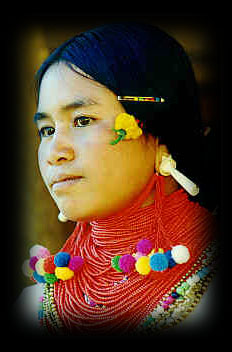 |
The hilltribes of Thailand-Lawa Information about the Lawa tribe in the highlands of Thailand. |
| Lahu |
|
|
Lahu people are to be found in the mountains of China, Myanmar (Burma), Laos and northern Thailand. There are four tribes within the Lahu: Black, Red, Yellow and She-Leh. Houses are built on high stilts with walls of bamboo or wooden planks, thatched with grass. The Lahu are independent people and love entertainment and the easy life. They are obviously pride themselves on their skills in hunting and trapping. |
The hilltribes of Thailand-Lahu Information about the Lahu people. |
| Lisu |
|
|
Villages of this colorful ethnic group are to be found in the mountains of China, Myanmar (Burma) and northern Thailand. They originate in eastern Tibet. Their house are built on the ground, with dirt floors and bamboo walls around a central ridge. For many generations the main means of livelihood for many of the Lisu people has been the cultivation of the opium poppy. Some of these people have given up poppy growing, and are now seeking to supplement their income through the sale of skillfully produced crafts. These hilltribe people are perhaps the best looking of all the tribes, and they like to think of themselves a little bit above their other hilltribe neighbors. 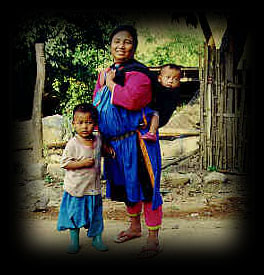 |
The hilltribes of Thailand-Lisu Information about the Lisu people. |
| Mlabri |
|
|
This tribe is known by the Thais as 'Phi Tong Luang', which means 'spirits of the yellow leaves'. There are only a few Mlabri still living in Thailand, just about 100 people. The Mlabri originate from Laos. These people are fragmented into extremely small, highly nomadic, family bands. They used to rely almost exclusively on hunting and gathering. By custom it is not allowed to own rice fields. |
The hilltribes of Thailand: MLABRI Information about the Mlabri people. |
| Palong | |
|
There are but a few Palong villages in Thailand, all of them in the northern part of Chiang Mai province along the border to Myanmar (Burma). Their main livelihood is the cultivation of tanatep, a large leaf to wrap burmese cigars. The Palongs are easily recognized by the striking custom of their women: red sarong like garments, mostly a blue jacket with red collar and broad silver waistbands. 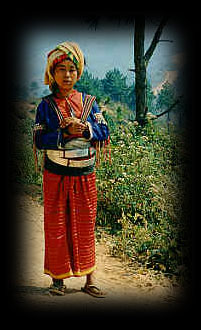 |
The hilltribes of Thailand: Palong Information about the Palong people. |
| Thins | |
|
This ethnic group have lived in Thailand for a long time, according to available reports. The Thins practise swidden agriculture. They grow glutinous rice, the staple rice of the northern Thai people. Their houses are built on piles with bamboo floors and walls. |
The hilltribes of Thailand: THINS Information about the Thins of Thailand. |
| Yao | |
|
They are to be found in China, Vietnam, Laos and Thailand. The Yao originate in southern China, and are the only hill tribe to have a written language. Yao villages are mostly found on low hills, and their houses built usually of wooden planks. There is a guest platform of bamboo in the communal living area. The Yao have a written religion based on medieval Chinese Taoism, although in recent years there have been many converts to Christianity and Buddhism. They are very peaceful and friendly, who pride themselves on cleanliness and honor and they are called the 'businessmen' among the hilltribes. 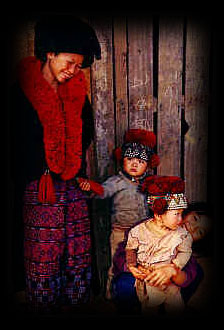 |
The hilltribes of Thailand-Yao Information about the Yao people. |
| Other Links | |
The hilltribes of Thailand Information about several tribes in the highlands of Thailand (Akha, Hmong, Yao, Karen, Lisu, Lahu, Lawa, Akha, Khamu, Thins, Mlabri, Palong). |
|